
Features
Crops
Flowers
Growing in the Green: Some summer standouts
October 26, 2012 By Melhem Sawaya
Even though it was a very hot summer, most of the 2000 varieties
performed very well and the heat-loving varieties provided a very
rewarding show for visitors to the 12th annual Sawaya Gardens
Container Trials.
Even though it was a very hot summer, most of the 2000 varieties performed very well and the heat-loving varieties provided a very rewarding show for visitors to the 12th annual Sawaya Gardens Container Trials.
The umbrellas they brought were used to keep the hot sun at bay … rain was rarely in the forecast!
There were a very few rainy nights, but fortunately most of the days were still sunny and hot. It is amazing how fast some plants recover, and how there was virtually no setback for them at all. However, others look like they went through the “heavy duty” cycle in a washing machine. These weaker varieties took five to seven days to recover, mainly from shattered flowers, and botrytis took care of the rest.
Surprisingly, many of the varieties that are not supposed to take heat very well performed especially well, including osteospermum and lobelia – the flowers lasted a very long time in our trials.
THE TEMPERATURE FACTOR WITH AVERAGE FLOWERING
■ What I’ve concluded is that flower longevity is related to the average temperature – the higher the temperature, the shorter the flowering time. However, if plants are outside in full sun, but are watered well, their flower power and strength is much better even under high temperatures.
Yet overall, it is still true that, in general, the higher the temperature, the weaker the flower life cycle, especially when light levels are low or the crop is overly shaded. That is why most plants flower better and longer outdoors in full sunlight than in the shade.
The main purpose of the Sawaya Garden Trials is to see how the varieties perform in our climate (southwestern Ontario). Over the past 12 years, we have seen some perform quite well and others not quite so well.
CALIBRACHOA PRODUCTION CONTINUES TO GROW
■ Over the past few years, production of calibrachoa has increased by over a thousand-fold throughout Canada. This significant increase is due to its excellent garden performance, and the amazing show it puts on from early spring to late fall as long as we fertilize it with every watering.
Ivy geranium in Ontario, on the other hand, is often a total loss as a garden performer. Hardly any of the regular types were produced. And yet the interspecific varieties, such as Caliente and the balcony types, are on the increase and they’re great. After all, we are growing plants for the ultimate consumer, and their success is our success.
All of our trial plants are donated and sold onsite by local hospital volunteers. Customers are amazed by the quality, and are happy to pay $20 a container for annuals … even on Aug. 20.
So, why are gardeners not always enjoying the full beauty of their plants?
The answer is simple: we are not communicating the information effectively to the ultimate consumer.
Unless we are willing to accept lower sales of 2.5 per cent or so every year, we’d better get together with our buyers (stores, garden centres) and industry specialists to develop effective ways to educate consumers. And we have to do this in addition to doing our homework in selecting the best garden performer varieties.
WHAT DO WE HAVE TO DO TO INCREASE PLANT SALES?
■ Here are some of the steps I feel are necessary to increase industry sales:
- Only grow varieties with proven, superior garden performance.
- Sell plants in larger containers than you are used to growing. Put flats material in much larger cells or 4” containers, and put 4” material in 6” containers. The rule-of-thumb is this; if you have to apply growth regulators more than once to make the plant fit into the container, it usually means the container is too small for the plant. Some examples include dahlia, blue salvia, Profusion zinnias, African marigolds, and gazania, to mention a few.
- Plant in a good potting media and avoid weird additives. Artificially extending the periods between watering in the greenhouse or garden centre offers a false expectation to the consumer. You’re only setting them up to fail.
- Top-dressing containers with slow-release fertilizer could be a setback for varieties that cannot take a heavy dose of fertilizer all at once, and that will happen when we get high temperatures. All slow-release fertilizers are released based on temperature and especially if the plants are not watered at required intervals.
- Provide liquid fertilizer free, as a bonus, with plant sales. Mix it in a 200 L barrel, heavily concentrated, so the consumer can dilute it to end up with a solution of about 150 ppm.
- If we don’t do anything else, why not sell simplified drip kits so homeowners can water their plants effectively and regularly? I guarantee you that plant sales will increase three to four per cent every year, instead of decreasing by two to three per cent.
MAKING GARDENING A LITTLE EASIER
■ I have first-hand experience with people who visit our trials.
They will ask about our drip system and I tell them where to buy it and how simple it is to put together. Those who install it always come back and thank me for the hint. They also tell me how they are going to buy many more plants because they know the plants are going to do very well and do so without any more work.
Get involved in advertizing plants and their benefits. In this industry, there is no sitting on the fence. If we are not part of the solution, we are part of the problem.
Here are some highlights from our trials this past hot summer.
It is not practical to share with you the performance of each of the 2,000 cultivars, so this year I decided to pick a few cultivars from among the many excellent performers. These varieties are not in any order of importance.
Remember, if you have never grown any of these varieties before and you want to, just grow a small trial sample to evaluate their success in production and then evaluate their consumer appeal. You can then decide to increase production or drop this variety. If you decide to increase production of a new variety after trialing for a season, make sure you take a good look at which variety you can drop.
DROUGHT-TOLERANT VARIETIES ARE INCREASINGLY POPULAR
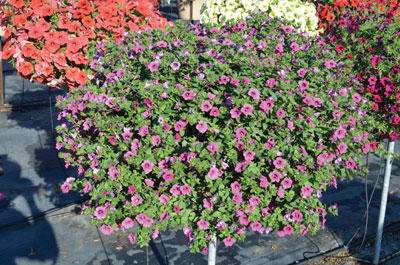 |
|
| 1. ‘Soleil Purple’ is a tough petunia with small flowers. PHOTOS COURTESY MELHEM SAWAYA |
|
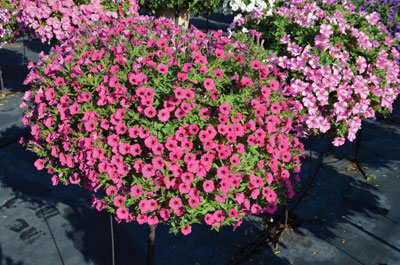 |
|
| 2 | |
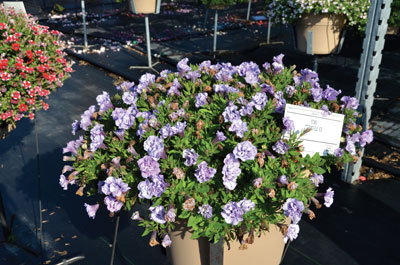 |
|
| 3 | |
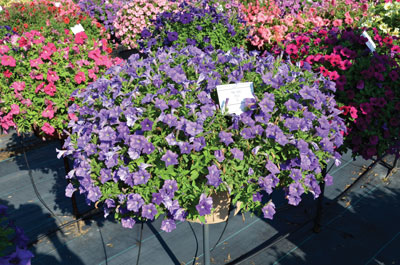 |
|
| 4 | |
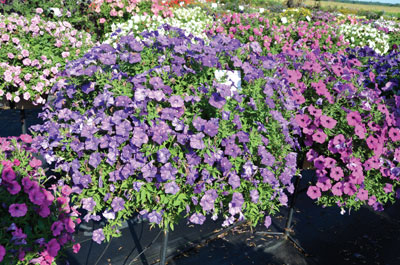 |
|
| 5 | |
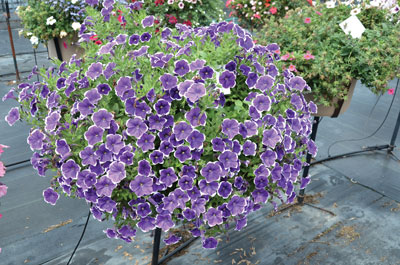 |
|
| 6 |
■ ‘Soleil Purple’ (1) is a tough petunia with small flowers. It would be my first choice among the many top-performing petunias. How many times have you seen a reference to a petunia variety and drought-resistance in the same sentence? Well, Soleil is that variety. The flowers last a long time and you will see different generations of flowers at the same time, and all will be in good condition. It is good for baskets and large containers, and excels in landscapes. Ask for it by name from your sales representative, because it is not promoted extensively.
‘Supertunia Sangria’ (2) petunia is the closest variety in every specification to the Soleil, except the ability to handle low water requirements.
‘Littletunia Blue Vein’ (3) is a double-flower multiflora petunia variety with excellent flower power. Like all other double petunias, the flowers get wilty when it rains, but they will dry up in a short time. The dead flowers need to be removed manually. ‘Blue Vein’ has an otherwise excellent habit. Its green foliage and compact growth provide high customer appeal if grown in colour-coordinated gallon containers.
‘Surfinia Patio Blue’ (4) is a mounding habit petunia with loads of medium-size flowers. It is great for baskets, in colour-matched gallon containers, and in
combinations where it enhances the look of the mix rather than overpowering the rest of the varieties. I call this a Combination Team Player (CTP).
‘Shock Wave Denim’ (5) is a seed petunia variety that has similar foliage and flowers to ‘Surfinia Patio Blue,’ but it has a trailing habit. So, if we call the Patio Surfinia filler, then the Shock Wave is a spiller.
‘Rhythm and Blues’ (6) is a petunia that has blue flowers with white edging that stands out whether you are close to it or admiring it from a distance. It could get loose in the greenhouse and overgrow many varieties in combinations, so early growth regulator treatments are needed.
MECARDONIA HAS SHONE IN TRIALS OVER THE YEARS
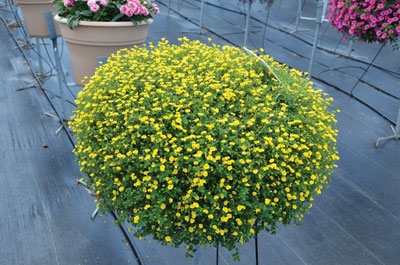 |
|
| 7 |
|
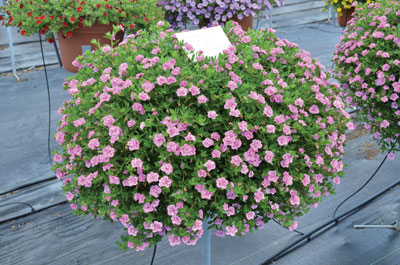 |
|
| 8 |
|
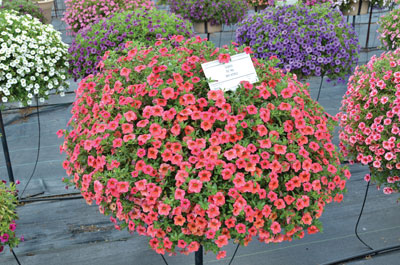 |
|
| 9 | |
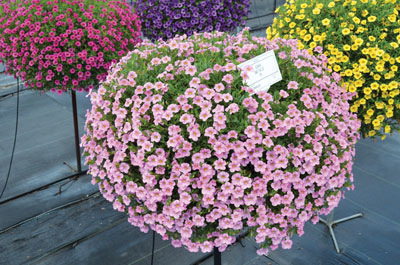 |
|
| 10 | |
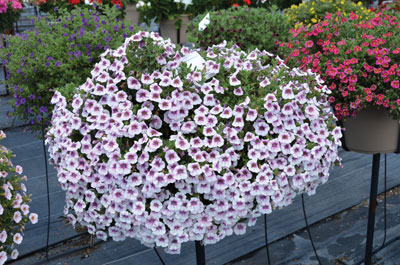 |
|
| 11 |
■ ‘Gold Dust Yellow’ (7) has an excellent habit the whole summer long. No deadheading is needed. If you are looking for a low-maintenance plant that has outstanding garden appeal, you cannot go wrong with mecardonia. We’ve had mecardonia in our trials the past four years, and every year it is the same outstanding variety – rain or shine!
‘Mini Famous Double Pink’ (8) calibrachoa is one of six colours in this double-flower series that has a medium vigour habit. Grow individual colours in baskets, or mixed, or in combination with other cultivars. Mini Famous Double definitely is definitely a (CTP) cultivar!
‘Mini Famous Compact Watermelon’ (9) is a mounding calibrachoa that has a vibrant colour and a medium growing habit. It is excellent in baskets and combinations.
‘Cabaret Light Pink’ (10) is a trailing calibrachoa with mounds of flowers. It has outstanding garden performance, much like other calibrachoa. Gardeners can’t get enough of calibrachoa!
‘Superbells Tickled Pink’ (11) is a two-tone colour calibrachoa with mounding habit and excellent performance. Superbells is a combination on its own, featuring pink flowers with deep pink throats.
FINISH CALIBRACHOAS ON THE COOL SIDE
■ Finish all calibrachoas on the cool side to optimize the growing habit, deepen the flower colour, and end up with a larger flower size.
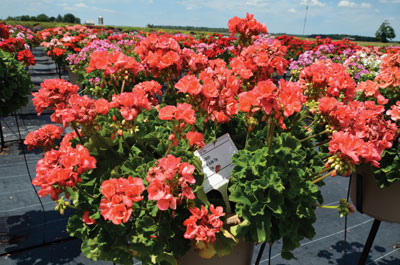 |
|
| 12 |
|
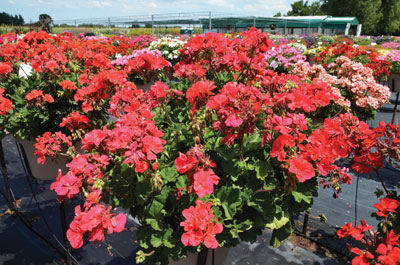 |
|
| 13 | |
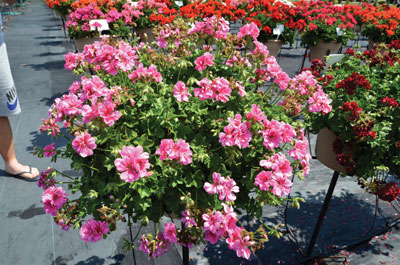 |
|
| 14 | |
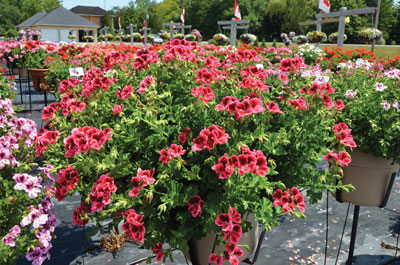 |
|
| 15 | |
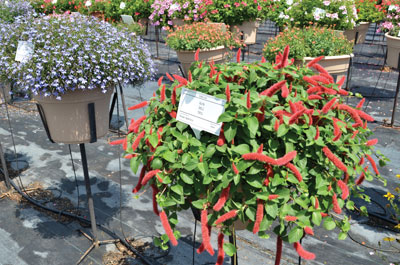 |
|
| 16 | |
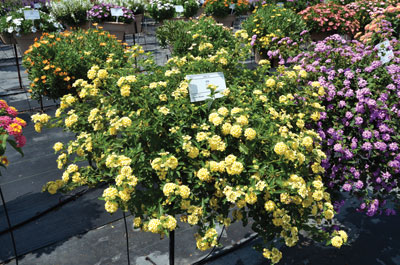 |
|
| 17 | |
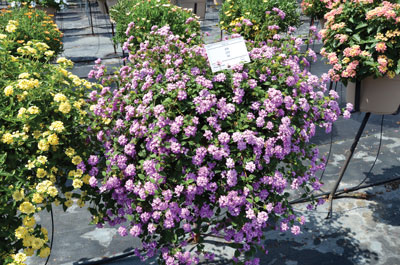 |
|
| 18 | |
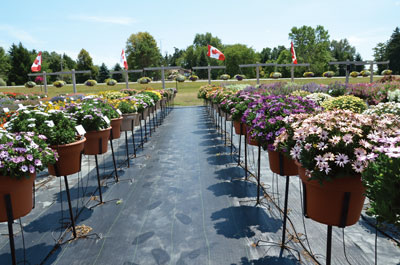 |
|
| 19 | |
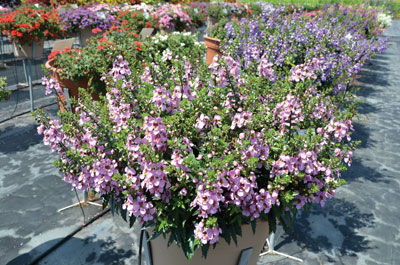 |
|
| 20 | |
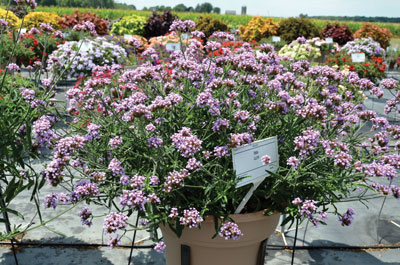 |
|
| 21 | |
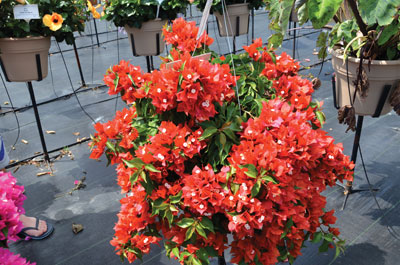 |
|
| 22 | |
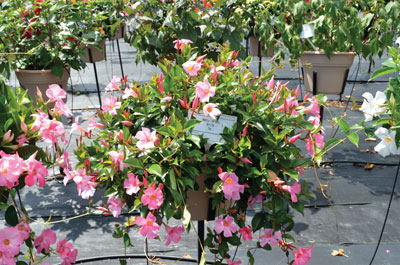 |
|
| 23 | |
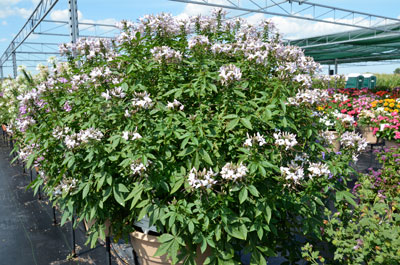 |
|
| 24 | |
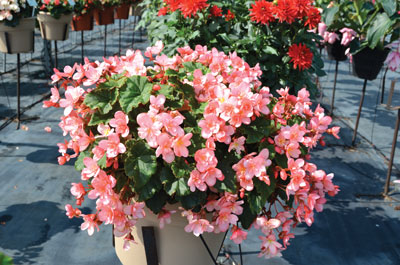 |
|
| 25 | |
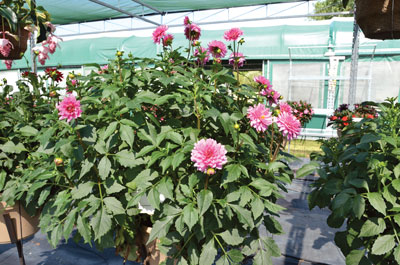 |
|
| 26 | |
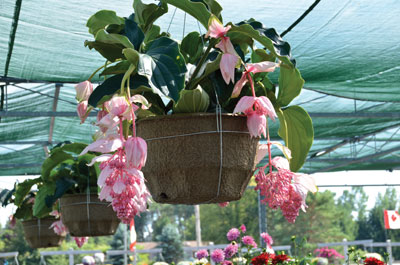 |
|
| 27 | |
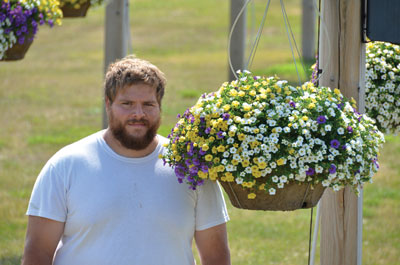 |
|
| 28 |
‘Salmon Pink’ (12) is one colour in the Survivor series that has a vigorous growing habit, which I like because it always provides better garden performance. ‘Salmon Pink’ has strong flowers on strong stems, can handle rainy weather fairly well, but the reality is that after a rain, deadheading is a must or any botrytis infected flowers will destroy the whole plant.
‘Sarita Punch’ (13) is one member of this series that is especially vigorous, which is the characteristic of interspecific varieties. A strong, good growth habit is great as long as it does not rain! (You have much better results with geraniums in the greenhouse when you keep water off the flowers.)
‘Great Balls of Fire’ (14) is a vigorous ivy geranium, that to my surprise, performed very well in the summer heat. This is the result of new breeding that takes into consideration North American summer climates.
Interspecific ‘Graziosa Royal Salmon’ (15) is a Martha Washington geranium type that grows surprisingly well in the summer. For those diehard gardeners who like Martha Washington type geraniums, you now have a variety that really can take the heat.
‘Firetail Chenille’ (16) is an acalypha variety that has consistently demonstrated excellent garden performance for the last 10 years; still I hardly see much production of it. It is excellent in baskets.
‘Luscious Lemonade’ (17) and ‘Luscious Berry Blend’ (18) are two very vigorous lantana varieties that could be big for greenhouse production if not growth regulated. Their garden performance is excellent, especially in hot dry summers, much like we just experienced. Try to mix the two varieties for an outstanding combination and grow in 14” or 16” hanging baskets.
OSTEOSPERMUM WORKS WELL THROUGHOUT THE SEASON
■ ‘Osteospermum 2012’ (19) are not the same old osteospermum varieties any more. Most of the varieties, if not all of them, will flower the whole summer long, so it is time to stop marketing them as a genus for cold times of the year. This creates a negative point of sale for two reasons:
- Producing osteospermum for early dates costs much more in energy costs.
- By promoting osteospermum as a cool crop, it’s tougher to sell it later in the season.
‘Archangel Pink’ (20) is another variety of a great garden performance genera. Angelonia loves the heat, does not need any deadheading, isn’t affected by rainfall, and flowers continuously throughout the season.
‘Lollipop’ (21) is an excellent verbena variety for landscapes and large containers. It also works quite well as a centrepiece in combinations. It flowers the whole summer. However, one note of caution – it could be susceptible to powdery mildew when such environmental conditions prevail!
‘Bougainvillea Vera Orange’ (22) is like the other colours in the Vera series. These are outstanding plants with a unique flower that stands out in a crowd, truly in a class of its own. It is very heat tolerant and loves very hot days and cooler nights, which will enhance the flower power. Bougainvillea works best in large containers.
‘Pretty Pink’ (23) is also a very heat-loving plant that grows well outdoors. Mandevilla is a long-season crop that requires high light intensity and temperatures. It is not a crop you can mix with other crops very easily without jeopardizing the quality of each crop.
LOOKING TO ADD SOME HEIGHT TO YOUR DESIGNS?
■ ‘Senorita Blanca’ (24) is a large cleome that performs great outdoors. Senorita is great in landscapes as a centre in circular designs or as a tall background plant.
It flowers the whole summer and is gardener friendly.
‘Cottage Salmon’ (25) is a Rieger begonia type loaded with small flowers. It has great outdoor performance and thrives on sun and heat. Rieger begonias, in general, are increasing in demand and especially in hanging baskets.
Dahlia ‘XXL Paraiso’ (26) has an especially impressive flower size. Make sure it is grown under long days through most of its production cycle in the greenhouse to get the maximum show.
‘Medinilla’ (27) is a new flower for Ontario, and is catching on fast. Medinilla can be grown indoors or outside. It is a high-end plant with flowers that last for a long time. It will flower again indoors after losing its first set of flowers.
A combination of ‘Cabaret Calibrachoa’ (28) put together by my son Thomas was among the highlights of the trials. Large hangers with continuous colour and low maintenance combinations are what consumers are requesting.
More trial pictures will be posted on my website at sawayagardentrials.ca .
Melhem Sawaya of Focus Greenhouse Management is a consultant and research coordinator to the horticultural industry. Comments on this or any other article are always welcome; please e-mail mel@focusgreenhousemanagement.com, or visit www.focusgreenhousemanagement.com.
Print this page